Business Law Assignment: Case Studies and Legal Principles
VerifiedAdded on 2021/04/21
|12
|2567
|58
Homework Assignment
AI Summary
This business law assignment comprehensively addresses various legal concepts within the UK legal framework. Part A delves into exclusion clauses, contract terms (conditions and warranties), frustration, misrepresentation, and the Sale of Goods Act. Part B analyzes a specific case related to contract terms, detailing the claimant's arguments, the court's decision, and the precedent used. Part C outlines the legislative process in the House of Representatives. Part D explores employment law, examining the control, integration, and multifactor tests used to determine employee status. Finally, Part E focuses on contract formation, specifically the elements of offer and acceptance, with application to a case study involving the sale of a watch, including the importance of timely acceptance via email communication. This assignment provides a detailed analysis of these legal principles and their application through case studies.
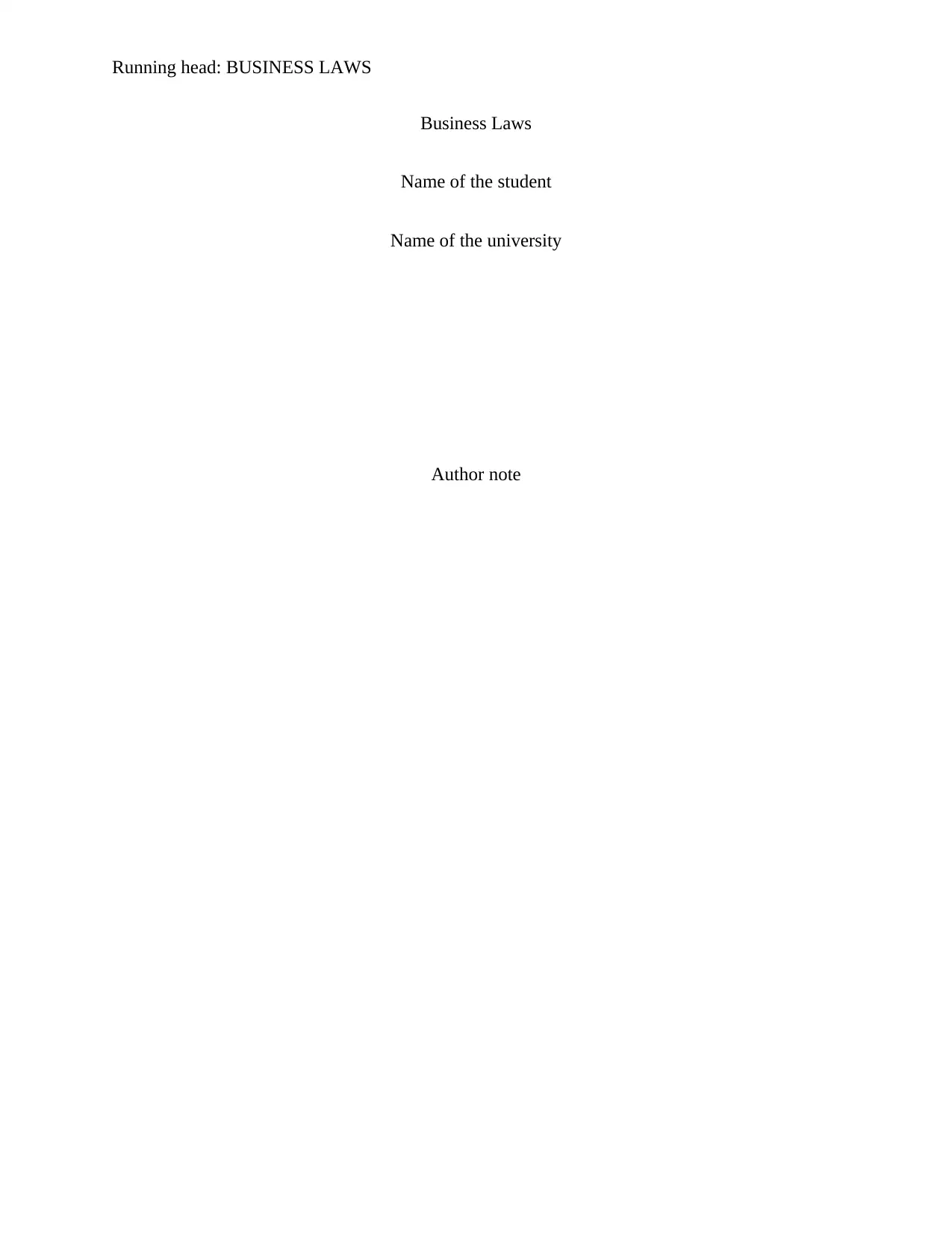
Running head: BUSINESS LAWS
Business Laws
Name of the student
Name of the university
Author note
Business Laws
Name of the student
Name of the university
Author note
Paraphrase This Document
Need a fresh take? Get an instant paraphrase of this document with our AI Paraphraser
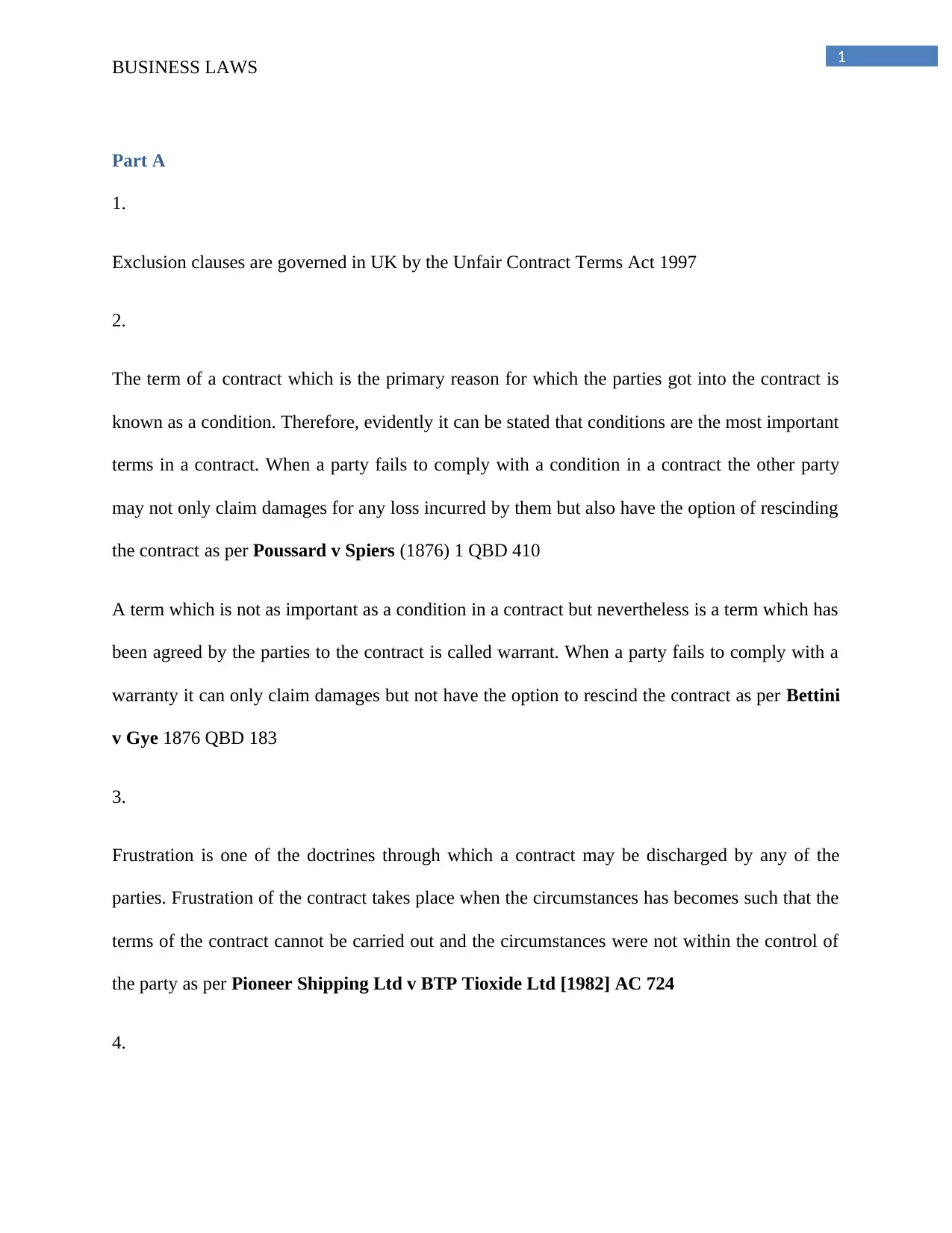
1
BUSINESS LAWS
Part A
1.
Exclusion clauses are governed in UK by the Unfair Contract Terms Act 1997
2.
The term of a contract which is the primary reason for which the parties got into the contract is
known as a condition. Therefore, evidently it can be stated that conditions are the most important
terms in a contract. When a party fails to comply with a condition in a contract the other party
may not only claim damages for any loss incurred by them but also have the option of rescinding
the contract as per Poussard v Spiers (1876) 1 QBD 410
A term which is not as important as a condition in a contract but nevertheless is a term which has
been agreed by the parties to the contract is called warrant. When a party fails to comply with a
warranty it can only claim damages but not have the option to rescind the contract as per Bettini
v Gye 1876 QBD 183
3.
Frustration is one of the doctrines through which a contract may be discharged by any of the
parties. Frustration of the contract takes place when the circumstances has becomes such that the
terms of the contract cannot be carried out and the circumstances were not within the control of
the party as per Pioneer Shipping Ltd v BTP Tioxide Ltd [1982] AC 724
4.
BUSINESS LAWS
Part A
1.
Exclusion clauses are governed in UK by the Unfair Contract Terms Act 1997
2.
The term of a contract which is the primary reason for which the parties got into the contract is
known as a condition. Therefore, evidently it can be stated that conditions are the most important
terms in a contract. When a party fails to comply with a condition in a contract the other party
may not only claim damages for any loss incurred by them but also have the option of rescinding
the contract as per Poussard v Spiers (1876) 1 QBD 410
A term which is not as important as a condition in a contract but nevertheless is a term which has
been agreed by the parties to the contract is called warrant. When a party fails to comply with a
warranty it can only claim damages but not have the option to rescind the contract as per Bettini
v Gye 1876 QBD 183
3.
Frustration is one of the doctrines through which a contract may be discharged by any of the
parties. Frustration of the contract takes place when the circumstances has becomes such that the
terms of the contract cannot be carried out and the circumstances were not within the control of
the party as per Pioneer Shipping Ltd v BTP Tioxide Ltd [1982] AC 724
4.
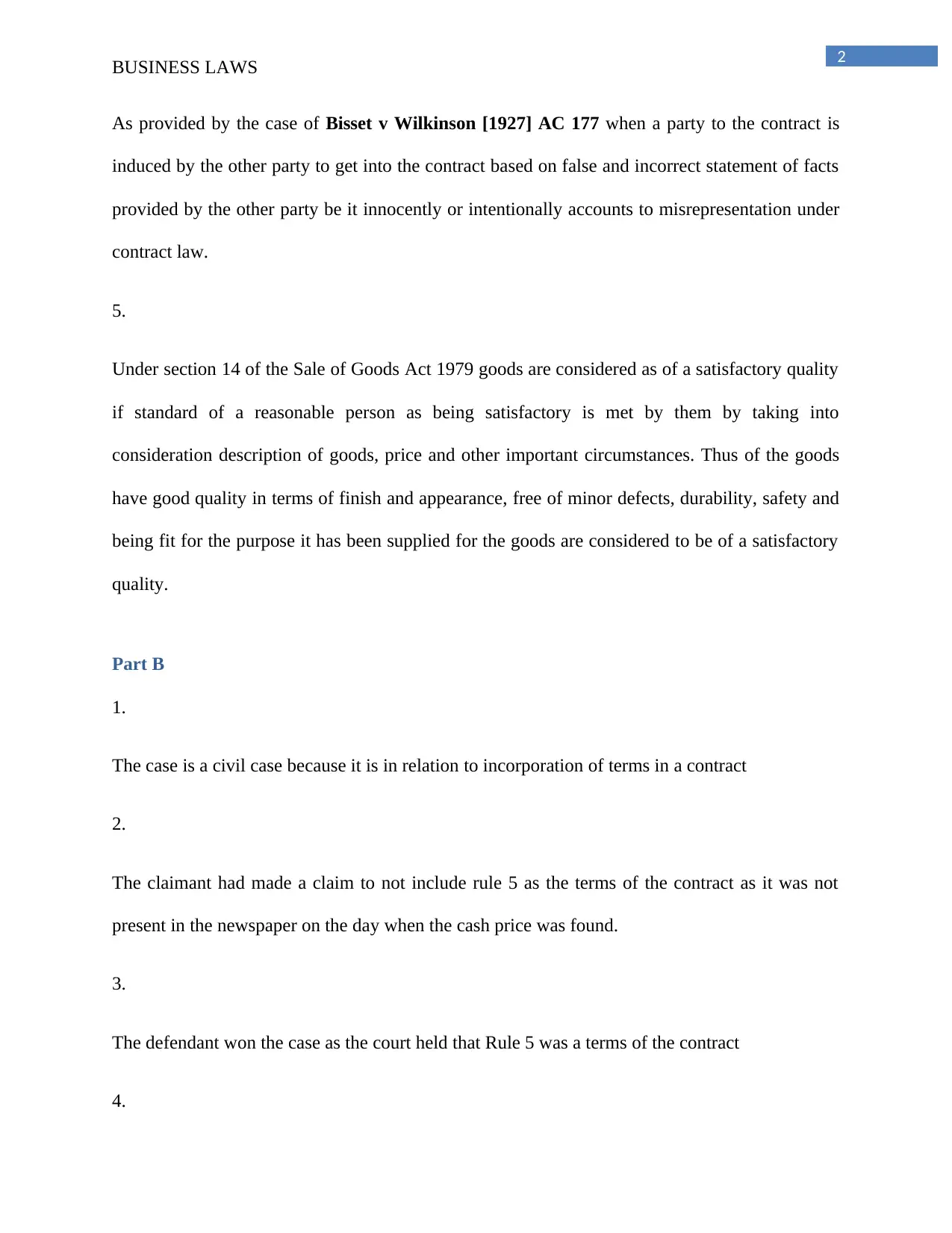
2
BUSINESS LAWS
As provided by the case of Bisset v Wilkinson [1927] AC 177 when a party to the contract is
induced by the other party to get into the contract based on false and incorrect statement of facts
provided by the other party be it innocently or intentionally accounts to misrepresentation under
contract law.
5.
Under section 14 of the Sale of Goods Act 1979 goods are considered as of a satisfactory quality
if standard of a reasonable person as being satisfactory is met by them by taking into
consideration description of goods, price and other important circumstances. Thus of the goods
have good quality in terms of finish and appearance, free of minor defects, durability, safety and
being fit for the purpose it has been supplied for the goods are considered to be of a satisfactory
quality.
Part B
1.
The case is a civil case because it is in relation to incorporation of terms in a contract
2.
The claimant had made a claim to not include rule 5 as the terms of the contract as it was not
present in the newspaper on the day when the cash price was found.
3.
The defendant won the case as the court held that Rule 5 was a terms of the contract
4.
BUSINESS LAWS
As provided by the case of Bisset v Wilkinson [1927] AC 177 when a party to the contract is
induced by the other party to get into the contract based on false and incorrect statement of facts
provided by the other party be it innocently or intentionally accounts to misrepresentation under
contract law.
5.
Under section 14 of the Sale of Goods Act 1979 goods are considered as of a satisfactory quality
if standard of a reasonable person as being satisfactory is met by them by taking into
consideration description of goods, price and other important circumstances. Thus of the goods
have good quality in terms of finish and appearance, free of minor defects, durability, safety and
being fit for the purpose it has been supplied for the goods are considered to be of a satisfactory
quality.
Part B
1.
The case is a civil case because it is in relation to incorporation of terms in a contract
2.
The claimant had made a claim to not include rule 5 as the terms of the contract as it was not
present in the newspaper on the day when the cash price was found.
3.
The defendant won the case as the court held that Rule 5 was a terms of the contract
4.
⊘ This is a preview!⊘
Do you want full access?
Subscribe today to unlock all pages.

Trusted by 1+ million students worldwide
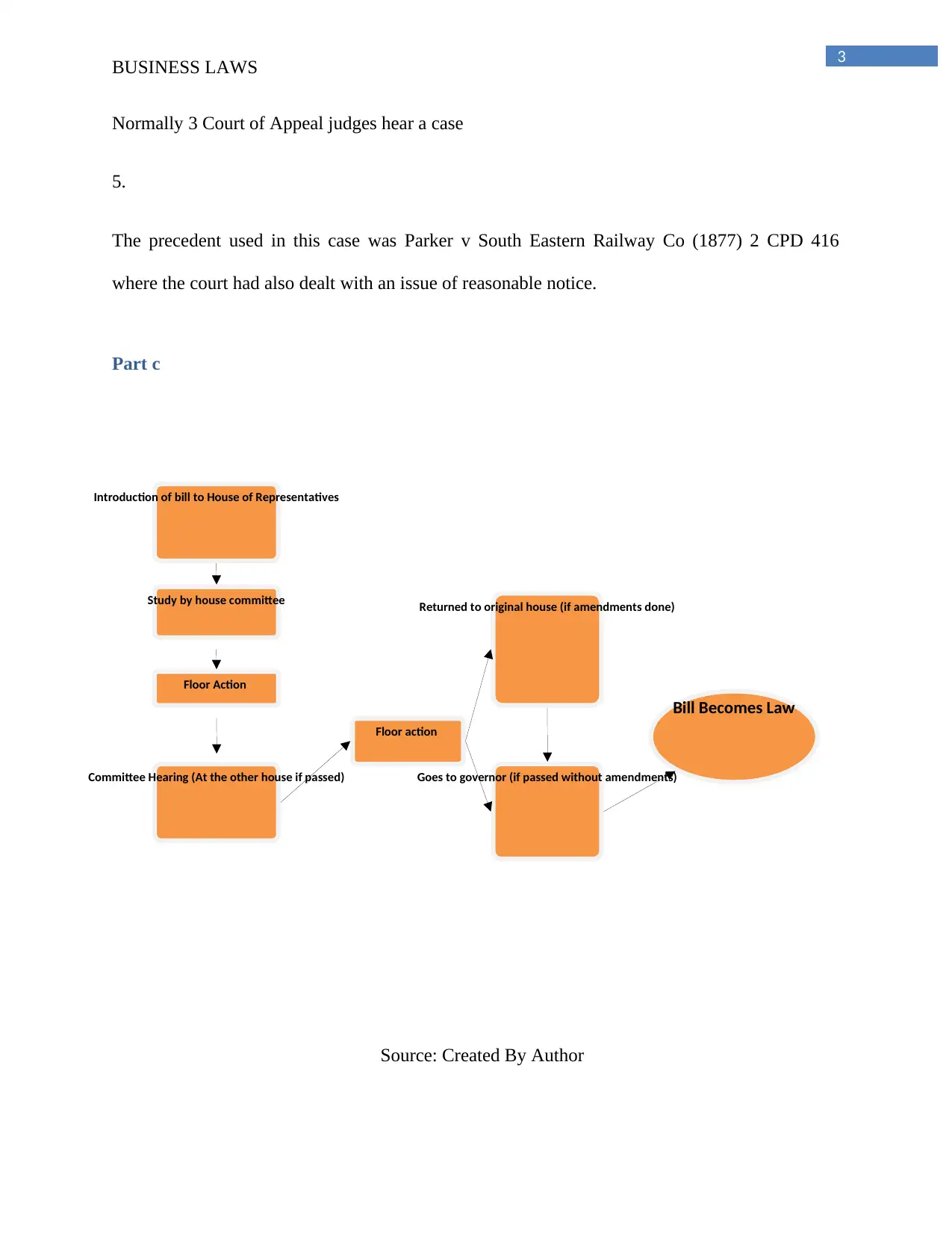
3
Introduction of bill to House of Representatives
Study by house committee
Floor Action
Committee Hearing (At the other house if passed)
Floor action
Returned to original house (if amendments done)
Goes to governor (if passed without amendments)
Bill Becomes Law
BUSINESS LAWS
Normally 3 Court of Appeal judges hear a case
5.
The precedent used in this case was Parker v South Eastern Railway Co (1877) 2 CPD 416
where the court had also dealt with an issue of reasonable notice.
Part c
Source: Created By Author
Introduction of bill to House of Representatives
Study by house committee
Floor Action
Committee Hearing (At the other house if passed)
Floor action
Returned to original house (if amendments done)
Goes to governor (if passed without amendments)
Bill Becomes Law
BUSINESS LAWS
Normally 3 Court of Appeal judges hear a case
5.
The precedent used in this case was Parker v South Eastern Railway Co (1877) 2 CPD 416
where the court had also dealt with an issue of reasonable notice.
Part c
Source: Created By Author
Paraphrase This Document
Need a fresh take? Get an instant paraphrase of this document with our AI Paraphraser
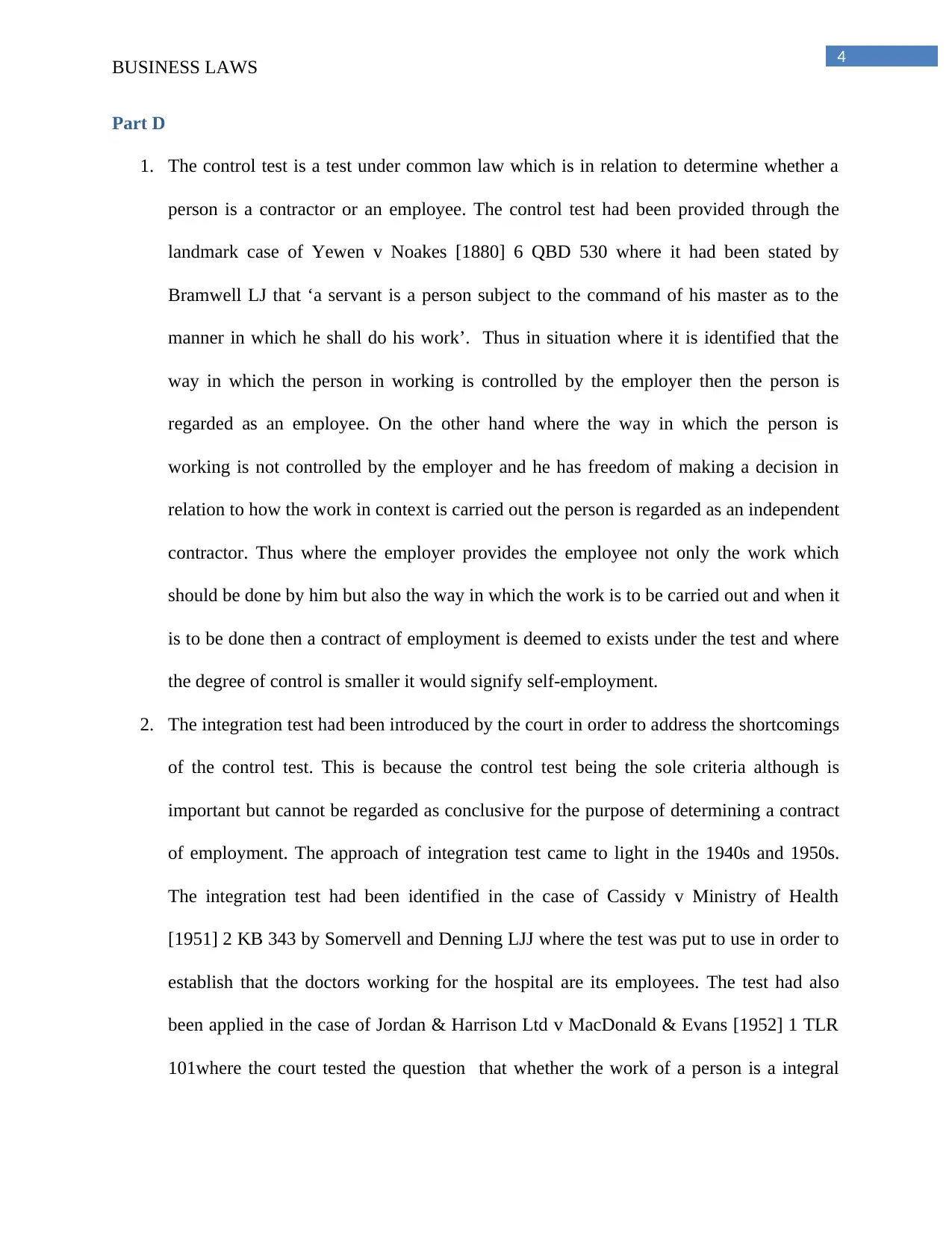
4
BUSINESS LAWS
Part D
1. The control test is a test under common law which is in relation to determine whether a
person is a contractor or an employee. The control test had been provided through the
landmark case of Yewen v Noakes [1880] 6 QBD 530 where it had been stated by
Bramwell LJ that ‘a servant is a person subject to the command of his master as to the
manner in which he shall do his work’. Thus in situation where it is identified that the
way in which the person in working is controlled by the employer then the person is
regarded as an employee. On the other hand where the way in which the person is
working is not controlled by the employer and he has freedom of making a decision in
relation to how the work in context is carried out the person is regarded as an independent
contractor. Thus where the employer provides the employee not only the work which
should be done by him but also the way in which the work is to be carried out and when it
is to be done then a contract of employment is deemed to exists under the test and where
the degree of control is smaller it would signify self-employment.
2. The integration test had been introduced by the court in order to address the shortcomings
of the control test. This is because the control test being the sole criteria although is
important but cannot be regarded as conclusive for the purpose of determining a contract
of employment. The approach of integration test came to light in the 1940s and 1950s.
The integration test had been identified in the case of Cassidy v Ministry of Health
[1951] 2 KB 343 by Somervell and Denning LJJ where the test was put to use in order to
establish that the doctors working for the hospital are its employees. The test had also
been applied in the case of Jordan & Harrison Ltd v MacDonald & Evans [1952] 1 TLR
101where the court tested the question that whether the work of a person is a integral
BUSINESS LAWS
Part D
1. The control test is a test under common law which is in relation to determine whether a
person is a contractor or an employee. The control test had been provided through the
landmark case of Yewen v Noakes [1880] 6 QBD 530 where it had been stated by
Bramwell LJ that ‘a servant is a person subject to the command of his master as to the
manner in which he shall do his work’. Thus in situation where it is identified that the
way in which the person in working is controlled by the employer then the person is
regarded as an employee. On the other hand where the way in which the person is
working is not controlled by the employer and he has freedom of making a decision in
relation to how the work in context is carried out the person is regarded as an independent
contractor. Thus where the employer provides the employee not only the work which
should be done by him but also the way in which the work is to be carried out and when it
is to be done then a contract of employment is deemed to exists under the test and where
the degree of control is smaller it would signify self-employment.
2. The integration test had been introduced by the court in order to address the shortcomings
of the control test. This is because the control test being the sole criteria although is
important but cannot be regarded as conclusive for the purpose of determining a contract
of employment. The approach of integration test came to light in the 1940s and 1950s.
The integration test had been identified in the case of Cassidy v Ministry of Health
[1951] 2 KB 343 by Somervell and Denning LJJ where the test was put to use in order to
establish that the doctors working for the hospital are its employees. The test had also
been applied in the case of Jordan & Harrison Ltd v MacDonald & Evans [1952] 1 TLR
101where the court tested the question that whether the work of a person is a integral
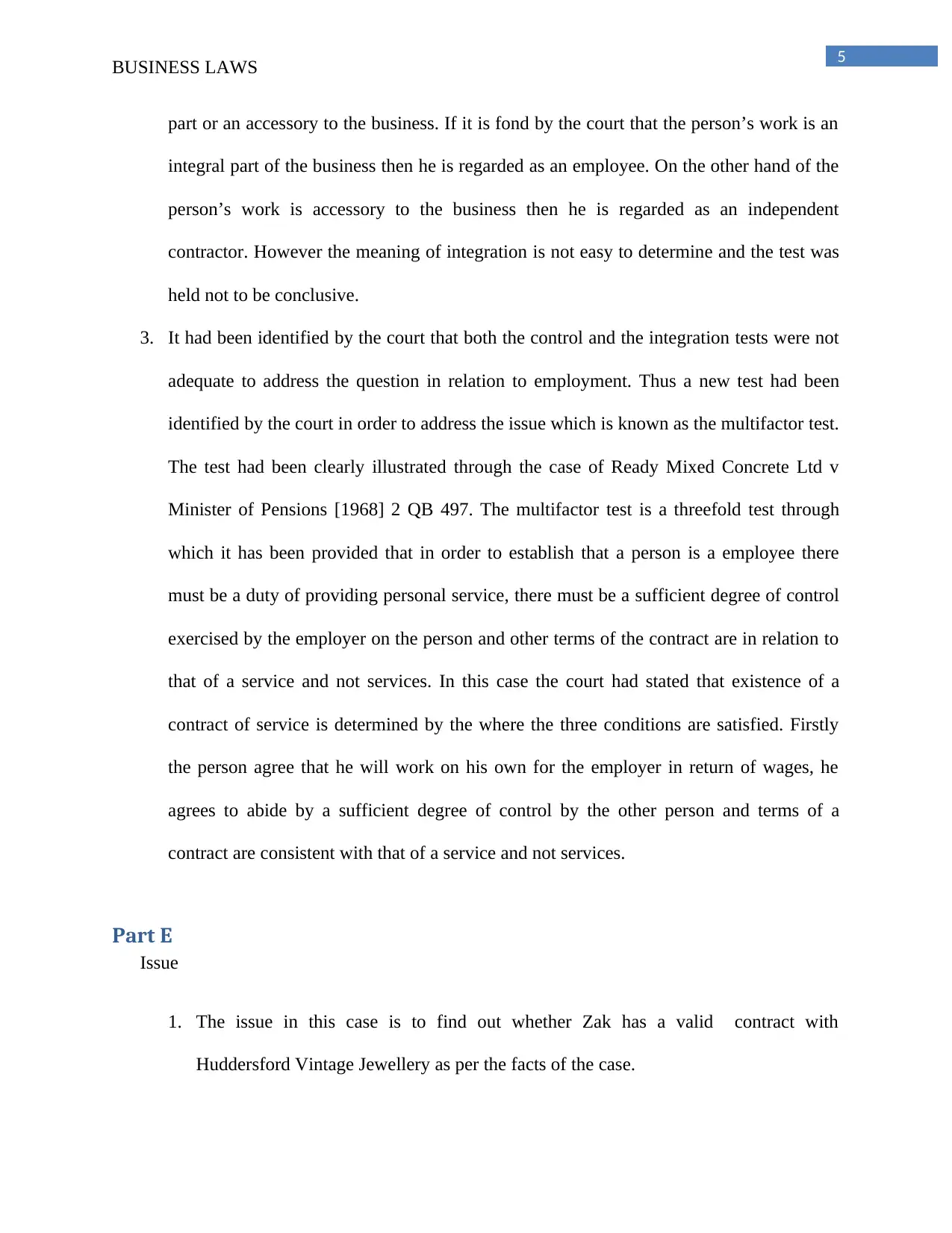
5
BUSINESS LAWS
part or an accessory to the business. If it is fond by the court that the person’s work is an
integral part of the business then he is regarded as an employee. On the other hand of the
person’s work is accessory to the business then he is regarded as an independent
contractor. However the meaning of integration is not easy to determine and the test was
held not to be conclusive.
3. It had been identified by the court that both the control and the integration tests were not
adequate to address the question in relation to employment. Thus a new test had been
identified by the court in order to address the issue which is known as the multifactor test.
The test had been clearly illustrated through the case of Ready Mixed Concrete Ltd v
Minister of Pensions [1968] 2 QB 497. The multifactor test is a threefold test through
which it has been provided that in order to establish that a person is a employee there
must be a duty of providing personal service, there must be a sufficient degree of control
exercised by the employer on the person and other terms of the contract are in relation to
that of a service and not services. In this case the court had stated that existence of a
contract of service is determined by the where the three conditions are satisfied. Firstly
the person agree that he will work on his own for the employer in return of wages, he
agrees to abide by a sufficient degree of control by the other person and terms of a
contract are consistent with that of a service and not services.
Part E
Issue
1. The issue in this case is to find out whether Zak has a valid contract with
Huddersford Vintage Jewellery as per the facts of the case.
BUSINESS LAWS
part or an accessory to the business. If it is fond by the court that the person’s work is an
integral part of the business then he is regarded as an employee. On the other hand of the
person’s work is accessory to the business then he is regarded as an independent
contractor. However the meaning of integration is not easy to determine and the test was
held not to be conclusive.
3. It had been identified by the court that both the control and the integration tests were not
adequate to address the question in relation to employment. Thus a new test had been
identified by the court in order to address the issue which is known as the multifactor test.
The test had been clearly illustrated through the case of Ready Mixed Concrete Ltd v
Minister of Pensions [1968] 2 QB 497. The multifactor test is a threefold test through
which it has been provided that in order to establish that a person is a employee there
must be a duty of providing personal service, there must be a sufficient degree of control
exercised by the employer on the person and other terms of the contract are in relation to
that of a service and not services. In this case the court had stated that existence of a
contract of service is determined by the where the three conditions are satisfied. Firstly
the person agree that he will work on his own for the employer in return of wages, he
agrees to abide by a sufficient degree of control by the other person and terms of a
contract are consistent with that of a service and not services.
Part E
Issue
1. The issue in this case is to find out whether Zak has a valid contract with
Huddersford Vintage Jewellery as per the facts of the case.
⊘ This is a preview!⊘
Do you want full access?
Subscribe today to unlock all pages.

Trusted by 1+ million students worldwide
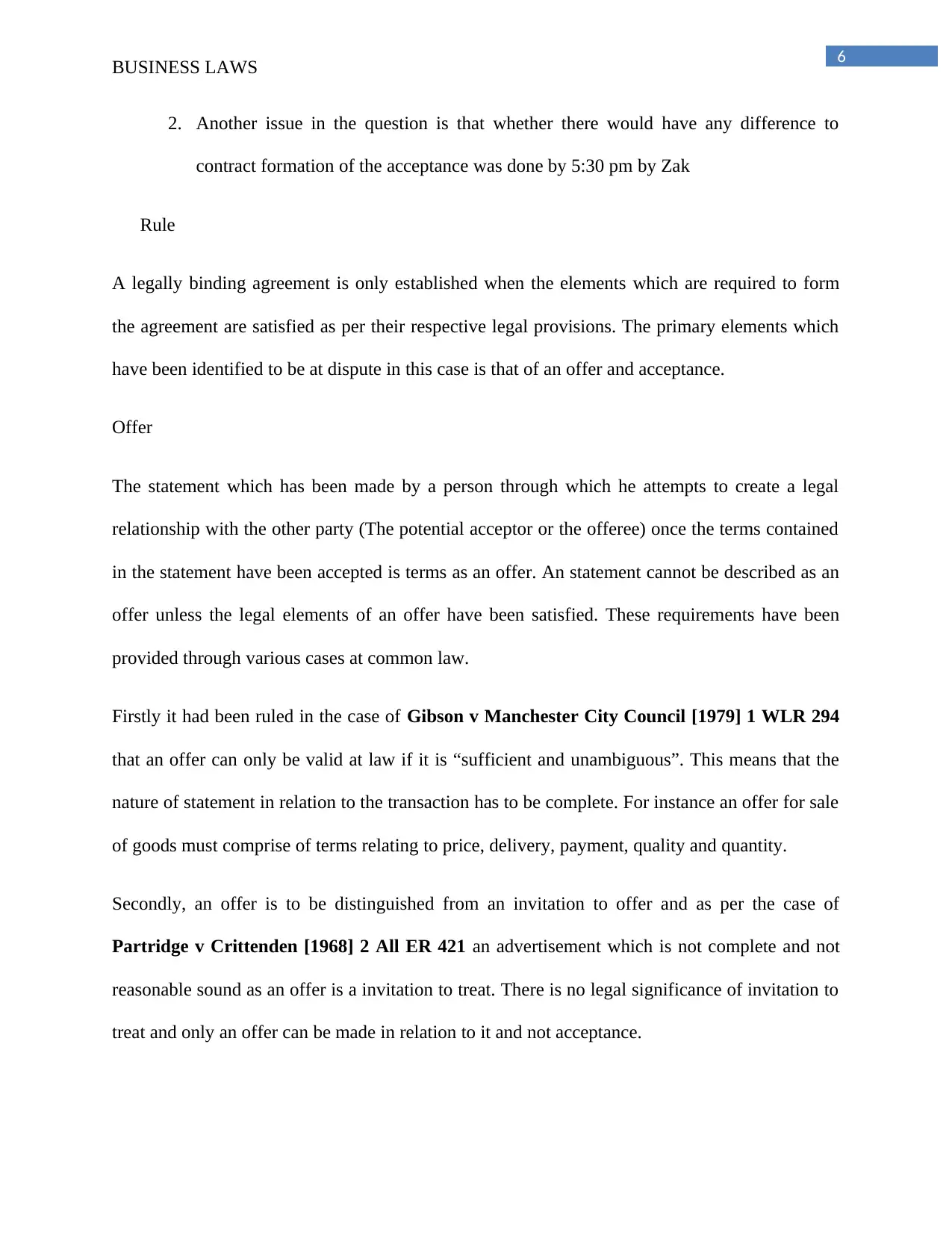
6
BUSINESS LAWS
2. Another issue in the question is that whether there would have any difference to
contract formation of the acceptance was done by 5:30 pm by Zak
Rule
A legally binding agreement is only established when the elements which are required to form
the agreement are satisfied as per their respective legal provisions. The primary elements which
have been identified to be at dispute in this case is that of an offer and acceptance.
Offer
The statement which has been made by a person through which he attempts to create a legal
relationship with the other party (The potential acceptor or the offeree) once the terms contained
in the statement have been accepted is terms as an offer. An statement cannot be described as an
offer unless the legal elements of an offer have been satisfied. These requirements have been
provided through various cases at common law.
Firstly it had been ruled in the case of Gibson v Manchester City Council [1979] 1 WLR 294
that an offer can only be valid at law if it is “sufficient and unambiguous”. This means that the
nature of statement in relation to the transaction has to be complete. For instance an offer for sale
of goods must comprise of terms relating to price, delivery, payment, quality and quantity.
Secondly, an offer is to be distinguished from an invitation to offer and as per the case of
Partridge v Crittenden [1968] 2 All ER 421 an advertisement which is not complete and not
reasonable sound as an offer is a invitation to treat. There is no legal significance of invitation to
treat and only an offer can be made in relation to it and not acceptance.
BUSINESS LAWS
2. Another issue in the question is that whether there would have any difference to
contract formation of the acceptance was done by 5:30 pm by Zak
Rule
A legally binding agreement is only established when the elements which are required to form
the agreement are satisfied as per their respective legal provisions. The primary elements which
have been identified to be at dispute in this case is that of an offer and acceptance.
Offer
The statement which has been made by a person through which he attempts to create a legal
relationship with the other party (The potential acceptor or the offeree) once the terms contained
in the statement have been accepted is terms as an offer. An statement cannot be described as an
offer unless the legal elements of an offer have been satisfied. These requirements have been
provided through various cases at common law.
Firstly it had been ruled in the case of Gibson v Manchester City Council [1979] 1 WLR 294
that an offer can only be valid at law if it is “sufficient and unambiguous”. This means that the
nature of statement in relation to the transaction has to be complete. For instance an offer for sale
of goods must comprise of terms relating to price, delivery, payment, quality and quantity.
Secondly, an offer is to be distinguished from an invitation to offer and as per the case of
Partridge v Crittenden [1968] 2 All ER 421 an advertisement which is not complete and not
reasonable sound as an offer is a invitation to treat. There is no legal significance of invitation to
treat and only an offer can be made in relation to it and not acceptance.
Paraphrase This Document
Need a fresh take? Get an instant paraphrase of this document with our AI Paraphraser
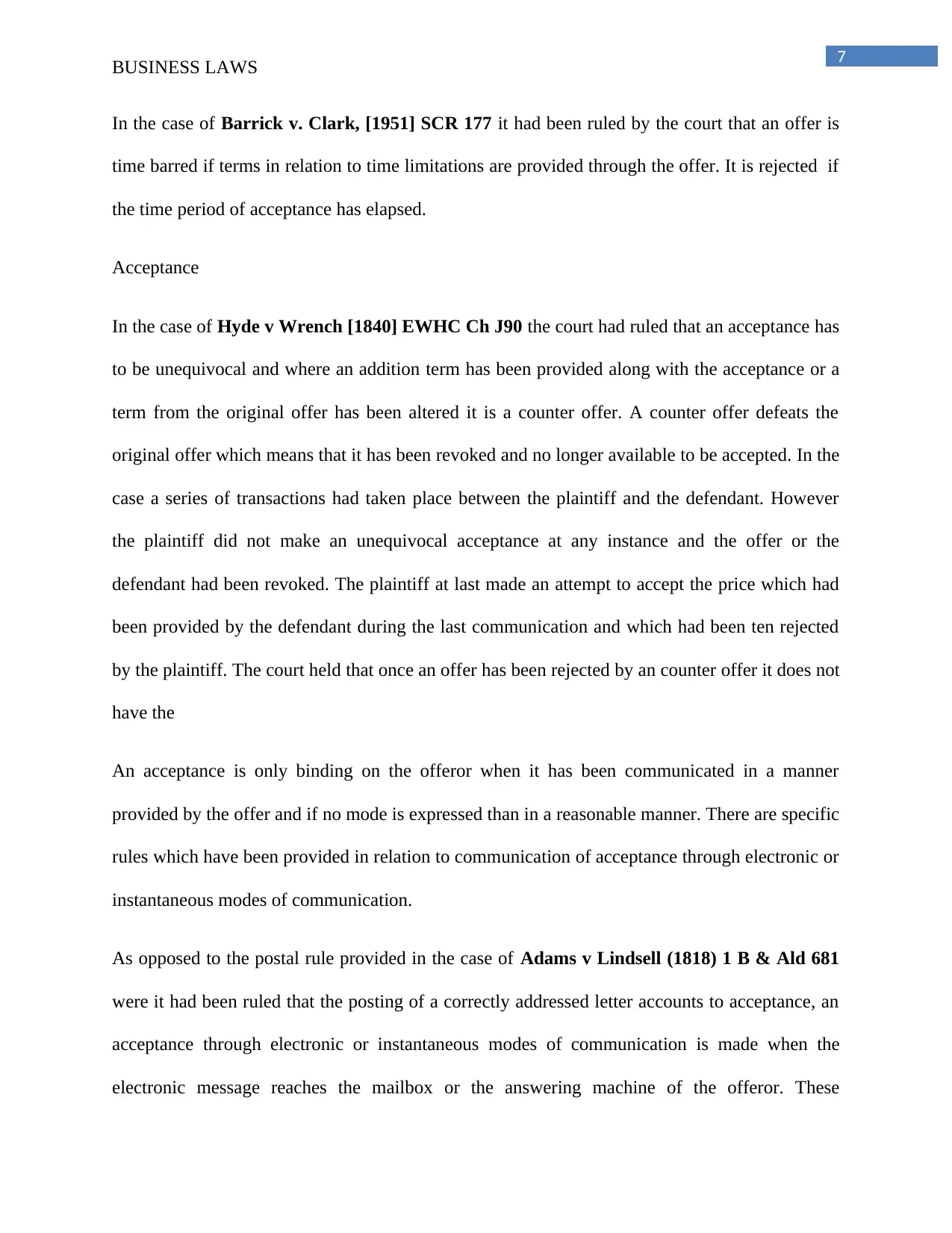
7
BUSINESS LAWS
In the case of Barrick v. Clark, [1951] SCR 177 it had been ruled by the court that an offer is
time barred if terms in relation to time limitations are provided through the offer. It is rejected if
the time period of acceptance has elapsed.
Acceptance
In the case of Hyde v Wrench [1840] EWHC Ch J90 the court had ruled that an acceptance has
to be unequivocal and where an addition term has been provided along with the acceptance or a
term from the original offer has been altered it is a counter offer. A counter offer defeats the
original offer which means that it has been revoked and no longer available to be accepted. In the
case a series of transactions had taken place between the plaintiff and the defendant. However
the plaintiff did not make an unequivocal acceptance at any instance and the offer or the
defendant had been revoked. The plaintiff at last made an attempt to accept the price which had
been provided by the defendant during the last communication and which had been ten rejected
by the plaintiff. The court held that once an offer has been rejected by an counter offer it does not
have the
An acceptance is only binding on the offeror when it has been communicated in a manner
provided by the offer and if no mode is expressed than in a reasonable manner. There are specific
rules which have been provided in relation to communication of acceptance through electronic or
instantaneous modes of communication.
As opposed to the postal rule provided in the case of Adams v Lindsell (1818) 1 B & Ald 681
were it had been ruled that the posting of a correctly addressed letter accounts to acceptance, an
acceptance through electronic or instantaneous modes of communication is made when the
electronic message reaches the mailbox or the answering machine of the offeror. These
BUSINESS LAWS
In the case of Barrick v. Clark, [1951] SCR 177 it had been ruled by the court that an offer is
time barred if terms in relation to time limitations are provided through the offer. It is rejected if
the time period of acceptance has elapsed.
Acceptance
In the case of Hyde v Wrench [1840] EWHC Ch J90 the court had ruled that an acceptance has
to be unequivocal and where an addition term has been provided along with the acceptance or a
term from the original offer has been altered it is a counter offer. A counter offer defeats the
original offer which means that it has been revoked and no longer available to be accepted. In the
case a series of transactions had taken place between the plaintiff and the defendant. However
the plaintiff did not make an unequivocal acceptance at any instance and the offer or the
defendant had been revoked. The plaintiff at last made an attempt to accept the price which had
been provided by the defendant during the last communication and which had been ten rejected
by the plaintiff. The court held that once an offer has been rejected by an counter offer it does not
have the
An acceptance is only binding on the offeror when it has been communicated in a manner
provided by the offer and if no mode is expressed than in a reasonable manner. There are specific
rules which have been provided in relation to communication of acceptance through electronic or
instantaneous modes of communication.
As opposed to the postal rule provided in the case of Adams v Lindsell (1818) 1 B & Ald 681
were it had been ruled that the posting of a correctly addressed letter accounts to acceptance, an
acceptance through electronic or instantaneous modes of communication is made when the
electronic message reaches the mailbox or the answering machine of the offeror. These
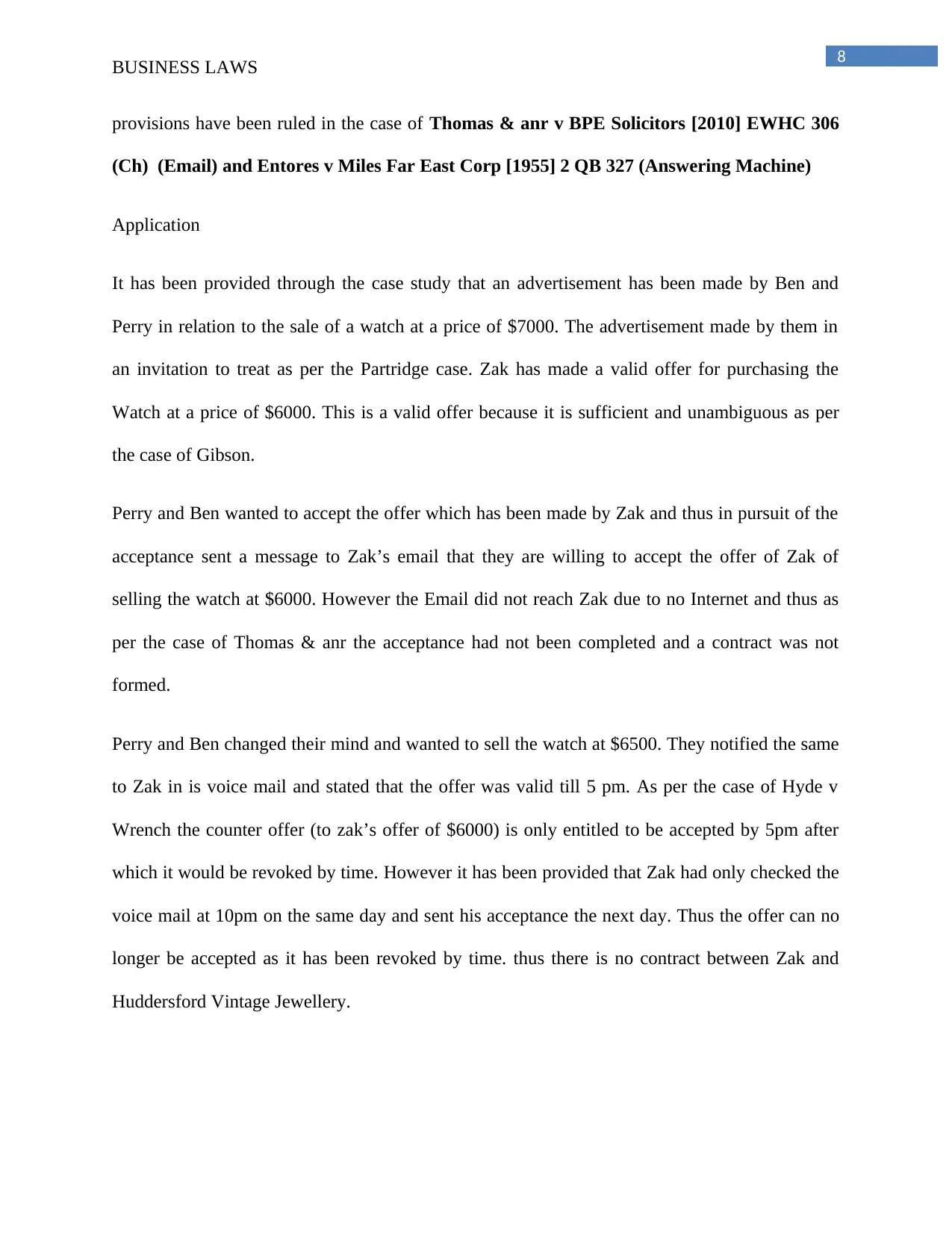
8
BUSINESS LAWS
provisions have been ruled in the case of Thomas & anr v BPE Solicitors [2010] EWHC 306
(Ch) (Email) and Entores v Miles Far East Corp [1955] 2 QB 327 (Answering Machine)
Application
It has been provided through the case study that an advertisement has been made by Ben and
Perry in relation to the sale of a watch at a price of $7000. The advertisement made by them in
an invitation to treat as per the Partridge case. Zak has made a valid offer for purchasing the
Watch at a price of $6000. This is a valid offer because it is sufficient and unambiguous as per
the case of Gibson.
Perry and Ben wanted to accept the offer which has been made by Zak and thus in pursuit of the
acceptance sent a message to Zak’s email that they are willing to accept the offer of Zak of
selling the watch at $6000. However the Email did not reach Zak due to no Internet and thus as
per the case of Thomas & anr the acceptance had not been completed and a contract was not
formed.
Perry and Ben changed their mind and wanted to sell the watch at $6500. They notified the same
to Zak in is voice mail and stated that the offer was valid till 5 pm. As per the case of Hyde v
Wrench the counter offer (to zak’s offer of $6000) is only entitled to be accepted by 5pm after
which it would be revoked by time. However it has been provided that Zak had only checked the
voice mail at 10pm on the same day and sent his acceptance the next day. Thus the offer can no
longer be accepted as it has been revoked by time. thus there is no contract between Zak and
Huddersford Vintage Jewellery.
BUSINESS LAWS
provisions have been ruled in the case of Thomas & anr v BPE Solicitors [2010] EWHC 306
(Ch) (Email) and Entores v Miles Far East Corp [1955] 2 QB 327 (Answering Machine)
Application
It has been provided through the case study that an advertisement has been made by Ben and
Perry in relation to the sale of a watch at a price of $7000. The advertisement made by them in
an invitation to treat as per the Partridge case. Zak has made a valid offer for purchasing the
Watch at a price of $6000. This is a valid offer because it is sufficient and unambiguous as per
the case of Gibson.
Perry and Ben wanted to accept the offer which has been made by Zak and thus in pursuit of the
acceptance sent a message to Zak’s email that they are willing to accept the offer of Zak of
selling the watch at $6000. However the Email did not reach Zak due to no Internet and thus as
per the case of Thomas & anr the acceptance had not been completed and a contract was not
formed.
Perry and Ben changed their mind and wanted to sell the watch at $6500. They notified the same
to Zak in is voice mail and stated that the offer was valid till 5 pm. As per the case of Hyde v
Wrench the counter offer (to zak’s offer of $6000) is only entitled to be accepted by 5pm after
which it would be revoked by time. However it has been provided that Zak had only checked the
voice mail at 10pm on the same day and sent his acceptance the next day. Thus the offer can no
longer be accepted as it has been revoked by time. thus there is no contract between Zak and
Huddersford Vintage Jewellery.
⊘ This is a preview!⊘
Do you want full access?
Subscribe today to unlock all pages.

Trusted by 1+ million students worldwide
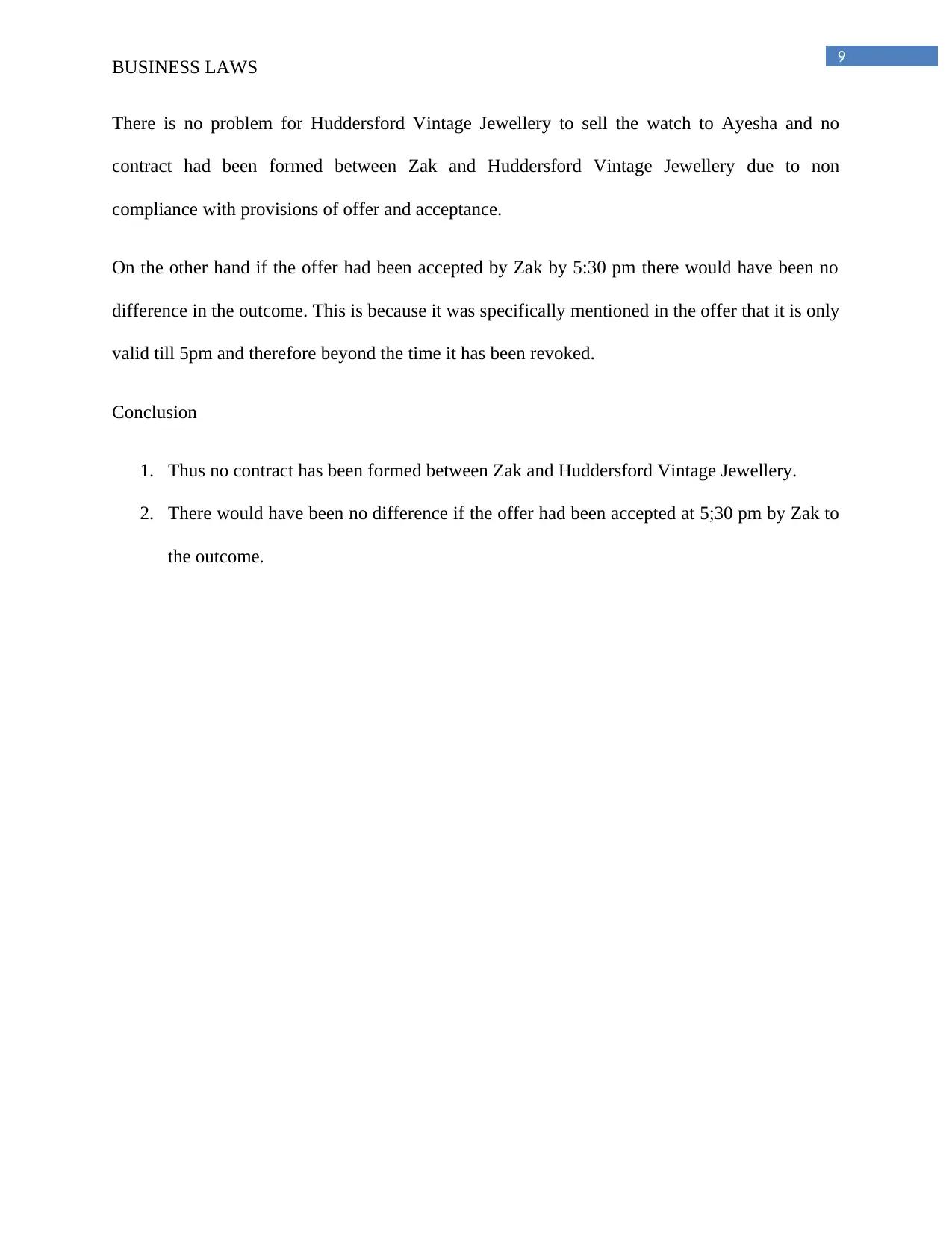
9
BUSINESS LAWS
There is no problem for Huddersford Vintage Jewellery to sell the watch to Ayesha and no
contract had been formed between Zak and Huddersford Vintage Jewellery due to non
compliance with provisions of offer and acceptance.
On the other hand if the offer had been accepted by Zak by 5:30 pm there would have been no
difference in the outcome. This is because it was specifically mentioned in the offer that it is only
valid till 5pm and therefore beyond the time it has been revoked.
Conclusion
1. Thus no contract has been formed between Zak and Huddersford Vintage Jewellery.
2. There would have been no difference if the offer had been accepted at 5;30 pm by Zak to
the outcome.
BUSINESS LAWS
There is no problem for Huddersford Vintage Jewellery to sell the watch to Ayesha and no
contract had been formed between Zak and Huddersford Vintage Jewellery due to non
compliance with provisions of offer and acceptance.
On the other hand if the offer had been accepted by Zak by 5:30 pm there would have been no
difference in the outcome. This is because it was specifically mentioned in the offer that it is only
valid till 5pm and therefore beyond the time it has been revoked.
Conclusion
1. Thus no contract has been formed between Zak and Huddersford Vintage Jewellery.
2. There would have been no difference if the offer had been accepted at 5;30 pm by Zak to
the outcome.
Paraphrase This Document
Need a fresh take? Get an instant paraphrase of this document with our AI Paraphraser
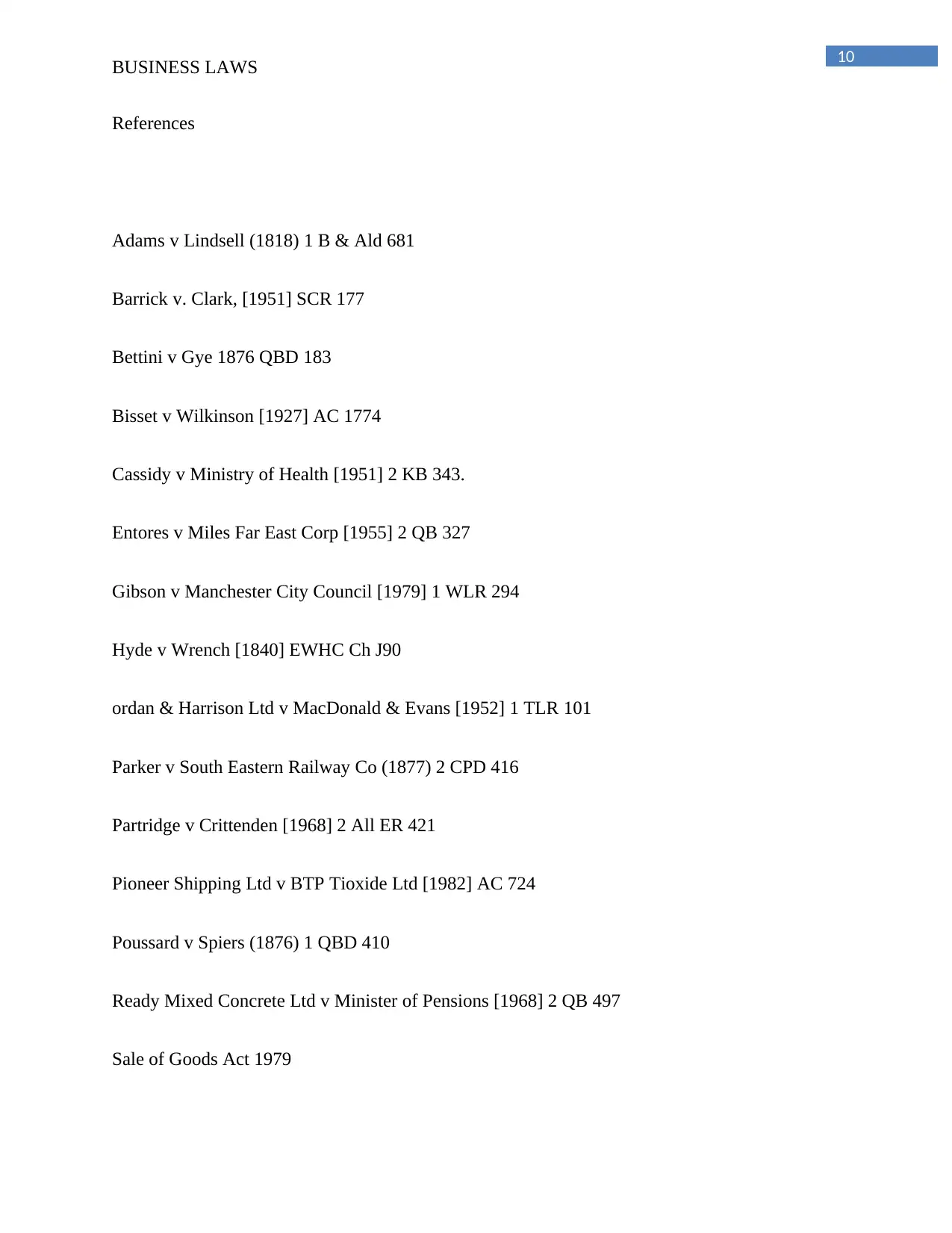
10
BUSINESS LAWS
References
Adams v Lindsell (1818) 1 B & Ald 681
Barrick v. Clark, [1951] SCR 177
Bettini v Gye 1876 QBD 183
Bisset v Wilkinson [1927] AC 1774
Cassidy v Ministry of Health [1951] 2 KB 343.
Entores v Miles Far East Corp [1955] 2 QB 327
Gibson v Manchester City Council [1979] 1 WLR 294
Hyde v Wrench [1840] EWHC Ch J90
ordan & Harrison Ltd v MacDonald & Evans [1952] 1 TLR 101
Parker v South Eastern Railway Co (1877) 2 CPD 416
Partridge v Crittenden [1968] 2 All ER 421
Pioneer Shipping Ltd v BTP Tioxide Ltd [1982] AC 724
Poussard v Spiers (1876) 1 QBD 410
Ready Mixed Concrete Ltd v Minister of Pensions [1968] 2 QB 497
Sale of Goods Act 1979
BUSINESS LAWS
References
Adams v Lindsell (1818) 1 B & Ald 681
Barrick v. Clark, [1951] SCR 177
Bettini v Gye 1876 QBD 183
Bisset v Wilkinson [1927] AC 1774
Cassidy v Ministry of Health [1951] 2 KB 343.
Entores v Miles Far East Corp [1955] 2 QB 327
Gibson v Manchester City Council [1979] 1 WLR 294
Hyde v Wrench [1840] EWHC Ch J90
ordan & Harrison Ltd v MacDonald & Evans [1952] 1 TLR 101
Parker v South Eastern Railway Co (1877) 2 CPD 416
Partridge v Crittenden [1968] 2 All ER 421
Pioneer Shipping Ltd v BTP Tioxide Ltd [1982] AC 724
Poussard v Spiers (1876) 1 QBD 410
Ready Mixed Concrete Ltd v Minister of Pensions [1968] 2 QB 497
Sale of Goods Act 1979

11
BUSINESS LAWS
Thomas & anr v BPE Solicitors [2010] EWHC 306 (Ch)
Yewen v Noakes [1880] 6 QBD 530
BUSINESS LAWS
Thomas & anr v BPE Solicitors [2010] EWHC 306 (Ch)
Yewen v Noakes [1880] 6 QBD 530
⊘ This is a preview!⊘
Do you want full access?
Subscribe today to unlock all pages.

Trusted by 1+ million students worldwide
1 out of 12
Related Documents
Your All-in-One AI-Powered Toolkit for Academic Success.
+13062052269
info@desklib.com
Available 24*7 on WhatsApp / Email
![[object Object]](/_next/static/media/star-bottom.7253800d.svg)
Unlock your academic potential
Copyright © 2020–2025 A2Z Services. All Rights Reserved. Developed and managed by ZUCOL.





